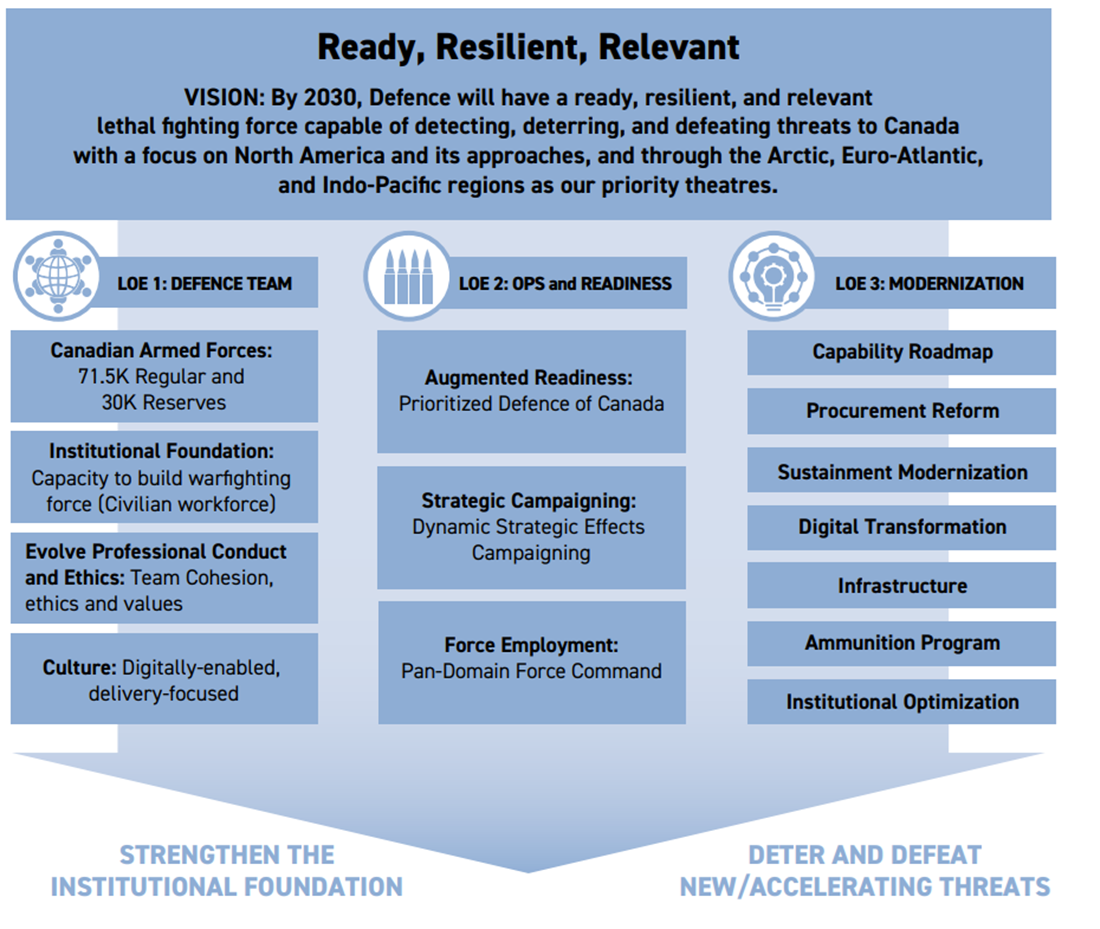Chief of the Defence Staff and Deputy Minister Directive for the Delivery of Ready, Resilient, and Relevant Forces
Archived content
This page was proactively published to meet the requirements of the Access to Information Act. It is a historical record which was valid when published, but may now contain information which is out of date.
Summary
- The Chief of the Defence Staff and Deputy Minister Directive for the Delivery of Ready, Resilient, and Relevant forces provides unified direction to direct and cohere the implementation of defence policy initiatives and areas of work.
- 14 Key Tasks across three lines of effort serve to prioritize activities, inform resource allocation, assign responsibility, and set the basis to measure and report on performance in achieving these objectives that are oriented towards two major outcomes – strengthening the institutional foundation of Defence and detecting, deterring, and defeating new and accelerating threats to Canada.
- This evergreen direction also lays the foundation for future growth and a path to spending 2% of Gross Domestic Product on defence.
Background
- The Chief of the Defence Staff (CDS) and Deputy Minister (DM) Directive for the delivery of Ready, Resilient, and Relevant Forces (February 2025) provides unified direction to implement signature defence policy initiatives and areas of work. Where defence policy sets out the objectives (ends) and provides the resources for their implementation (means), the directive sets out the ways in which they will be implemented. In so doing, it prioritizes tasks, informs resource allocation, assigns responsibility to Level 1 organizations, and sets the basis for a performance management framework.
- The directive sets out a vision where by 2030, Canada will have ready, resilient, and relevant lethal fighting forces capable of detecting, deterring, and defeating threats to Canada with a focus on North America and its approaches, and through the Arctic, Euro-Atlantic, and Indo-Pacific regions as our priority theatres.
- To realize this vision, priority efforts are described across three lines of effort: first, Strengthening the Defence Team; second, Delivering Operations and Enhancing Readiness; and third, Modernizing our Forces and Institution. 14 Key Tasks populate these lines of effort and contain cross-cutting initiatives deemed most essential to realizing the vision by 2030. The two ultimate outputs of this work are to strengthen the institutional foundation of defence and detect, deter, and defeat new and accelerating threats to Canada (see Annex A for the Ready, Resilient, Relevant framework).
Considerations
- To ensure prioritized and accelerated delivery of the key tasks, the Vice Chief of the Defence Staff will provide amplifying guidance on the sequencing, timelines, resource allocation and interdependencies amongst the 14 Key Tasks.This guidance will be kept evergreen as work progresses and will form the basis for an effective performance management regime to ensure accountability and results.
- Over the longer term, this guidance may be absorbed into departmental governance mechanisms to create the intended effect, including business planning that directs tasks, allocates resources, and measures performance over time.
- The directive also lays the foundation for future growth and a path to spending 2% of gross domestic product (GDP) on defence. Reinforcing the foundation of Defence – our people, readiness, forces and institution – is necessary in order to be sustainable and resilient in developing, generating, managing, sustaining, and employing the forces required to meet the Defence vision and grow the force towards the 2% of GDP commitment.
- As new initiatives or signature programs are introduced, it will be important to consider how they are integrated and cohered with ongoing initiatives, and any knock-on effects in terms of reprioritization or adjustments to existing programs of work.
Conclusion
- The CDS and DM Directive for the Delivery of Ready, Resilient, and Relevant Forces brings the necessary prioritization, resource allocation, accountability, and performance measurement to defence policy implementation and to cohere signature programs of work ongoing within Defence.
Annex A: Ready, Resilient, Relevant Framework

Caption
Ready, Resilient, Relevant
Vision: By 2023, Defence will have a ready, resilient, and relevant lethal fighting force capable of detecting, deterring, and defeating threats to Canada with a focus on North America and its approaches, and through the Arctic, Euro-Atlantic, and Indo-Pacific regions as our priority theatres.
Line of effort 1: defence Team
- Canadian Armed Forces
- 71.5K Regular and 30K Reserves
- Institutional Foundation:
- Capacity to build warfighting force (Civilian workforce)
- Evolve Professional Conduct and Ethics:
- Team Cohesion, ethics and values
- Culture:
- Digitally-enabled, delivery-focused
Line of effort 2: OPS and Readiness
- Augmented Readiness:
- Prioritized Defence of Canada
- Strategic Campaigning:
- Dynamic Strategic Effects Campaigning
- Force Employment:
- Pan-Domain Force Command
Line of effort 3: Modernization
- Capability Roadmap
- Procurement Reform
- Sustainment Modernization
- Digital Transformation
- Infrastructure
- Ammunition Program
- Institutional Optimization
Strengthen the Institutional Foundation
Deter and Defeat New/Accelerating Threats